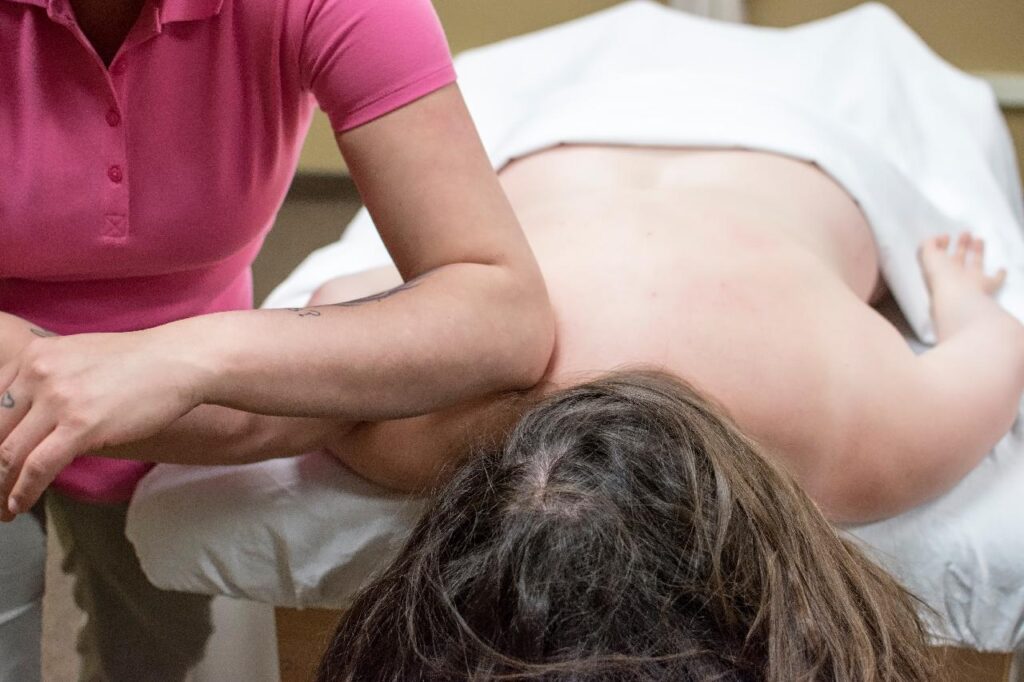Sports Massage and Direct-Indirect Technique
As I watched the Olympics, I was struck by the competitive spirit of the athletes. It didn’t matter how small or large they were. From tiny gymnasts and svelte swimmers to large hammer throwers and massive shot putters, they were all out to compete to the best of their ability. And they were all probably getting some form of sports massage.
In a world where body-shaming is popular and advertisements tell us that everyone should be lean and elegant, it was refreshing to see athletes of ALL body types excel on the Olympic stage, whether they got a medal or not.

USA hammer thrower, DeAnna Price, did her absolute best and competed with the same kind of passion we see with more visible track, swimming, and team athletes. DeAnna had excelled at the USA Olympic trials, with the second farthest hammer throw in history at over 80 meters. However, after the USA trials, she injured her ankle with a bone bruise, followed by a hip injury.
Competing through her injuries, DeAnna still managed to place 8th in the event. Though it was far from the success she had at winning the World Championship in Qatar in 2019, it was a courageous effort. And I was thrilled to watch her compete.
The Little-Known Sports Massage Secret
Sports massage has been around for a long time. The earliest known references are from the Olympic games of ancient Greece, over 2500 years ago. Now, athletes of all kinds get massage therapy regularly: baseball players, tennis pros, swimmers, everyone.
When I taught sports massage in massage school years ago, I presented the accepted curriculum, but I also drew on my own experience. I personally have worked on many college and professional football players, basketball players, tennis players, golfers, cheerleaders, runners, and more. Interestingly, the worst head injuries I saw were among the cheerleaders. Sometimes, they forget to catch them when they’re thrown into the air!
The standard sports massage curriculum emphasizes pre-event, inter-event, and post-event techniques. The first two are about keeping muscles loose and keeping circulation moving, while the latter focuses on recovery and rehabilitation.
The techniques for pre-event and inter-event are somewhat aggressive, including lots of petrissage, compression, percussion, and friction. The movements are relatively fast. They’re not meant to be super-relaxing.
The little-known sports massage secret is that pre-event and inter-event techniques are important. But they only account for about 10% of the massage work that athletes need and get. (Btw, I made that statistic up, based solely on my experience and that of sports massage therapists I know.) The vast majority of the massage work that athletes need involves recovery and rehabilitation. Period.

Direct-Indirect Technique as Sports Massage
This is where Direct-Indirect Technique comes in. With DIT, you have the tools to help a vast array of athletes, as well as non-athletes. During the DIT trainings, you learn how to relieve pain and loosen tight muscles and fascia in ways that go well beyond typical massage techniques. Unless you’re traveling with a team and focusing solely on pre-event work, these are the tools you need to help athletes…and everyone else.
In the DIT for Upper and Lower Back and Legs class, you learn how to help people with tight upper back problems, low back pain, hip soreness, sciatica, hamstring or quad issues, knee problems, plantar fascitis, shin splints, and much more.
With the DIT for Shoulder, Arm, Neck, Head, and TMJ class, you learn how to help people with stiff necks, shoulder problems, tennis or golf elbow, wrist and hand issues, thoracic outlet syndrome, frozen shoulder, TMJ dysfunction, and so much more.
I have used the DIT combination of deep Direct and gentle Indirect techniques on athletes of all kinds with lots of success over many years. Hundreds of my students have expressed that they also have had similar success with these techniques. The reason is because they work! Simple as that. And I teach them in a way that makes it easy for you to learn them, practice them, and incorporate them into your bodywork practice. They will fit nicely with the techniques you’re already using.
Register for an upcoming Ray of Light Training Direct-Indirect Technique class and add some successful tools to your toolbox to help athletes and couch potatoes and everyone in between.
You can learn more about DeAnna Price and her many accomplishments here.
Stay well,
John
John Joseph Ray
Ray of Light Training
John is a Board Approved Continuing Education Provider through the NCBTMB
Member of the Fascia Research Society
